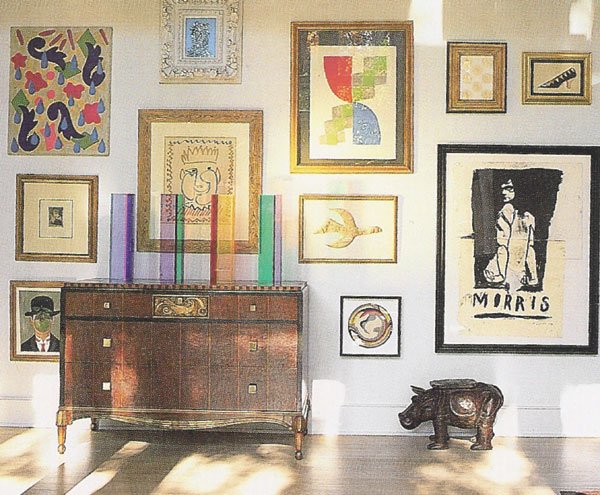I’m a great proponent of putting your personal stamp, your
imprint, on every room in your house. And what better way is there
to personalize your space than by selecting what is going to
decorate your wall, be it a series of black-and-white photographs,
a water color purchased at a flea market or a grouping of
wonderfully ornate mirrors?
I’m a great proponent of putting your personal stamp, your imprint, on every room in your house. And what better way is there to personalize your space than by selecting what is going to decorate your wall, be it a series of black-and-white photographs, a water color purchased at a flea market or a grouping of wonderfully ornate mirrors?
As my friend, author Stephanie Hoppen, says in her new book “The New Decorating with Pictures” (Bulfinch, 2004), “meaningful wall art … adds warmth, personality, depth, interest, texture and, most of all, soul to the life and spirit of the home.”
This is one area of decorating where you can afford to be adventurous and experimental because you have the flexibility of simply moving objects around, such as replacing one framed object – a photograph, for example – with a painting, mirror or tapestry.
Still, for many people, where and what to hang on their walls is one of the toughest design decisions they’ll have to make. They’ve chosen the paint color for the walls, put down the rug and arranged the furniture. But they just can’t commit to where to hang a picture. I have friends who can’t wait to show me the work they’ve done in their homes and, when I go in, the elements are there – the paint, curtains, furniture – but the walls remain bare. Instead, stacks of pictures rest on the floor or lean against doorways as if the pictures themselves just can’t decide to come in the room, much less find their homes on the walls.
If you are one of those living with empty walls or have a fear of putting in an unnecessary nail hole, consider:
nA picture is not permanent: There is no rule in decorating that says once you position a picture it has to stay there forever. If your walls are empty because you’re waiting for that one special piece of art to “speak to you,” something that “matches your colors” or just one of your photos to be worthy of a frame, get over it. Hang something that pleases you today, be it that poster advertising a favorite art show or museum, your child’s weekly offering from nursery school or a seasonal print. Then change it out the next time something else strikes your fancy.
Nail holes are easy to fill and always keep a small bottle of touch-up paint
at the ready. I have a
collection of baby food jars filled and labeled with touch-up paint for each room in my house. But white toothpaste serves as a perfectly satisfactory filler for white walls.
nEmbrace a salon style: Hang an eclectic group of pictures, mirrors and objects. This look is for someone who is fearless with a hammer and picture hooks. Create an entire wall display by mixing different art mediums, frame styles, visual weights, colors and designs.
One of my favorite designers, John Oetgen of Atlanta, hung a floor-to-ceiling display in his own living room that celebrates his love of art and style by clustering together pieces by Picasso, Degas, Warhol, Sonia Delaunay, Todd Murphy and, with them, a simple painted paper plate. He also included one of his own whimsical paintings in the mix for the ultimate personal statement. This look does require some confidence in your art choices, alongside a belief that if you love them all, they will work together.
nSymmetrical or asymmetrical: How you hang things reflects your personality and style. Decorating a wall with framed mirrors, art or objects is all about arranging objects in a space.
Some spaces almost demand symmetry – the formal, balanced arrangement of like-scaled, matching frames and complementary art styles – including a traditionally styled living room or bedroom. Other wall areas seem more at home with a casual, asymmetrical arrangement typically found in a family room, media room or kitchen.
The style of art itself can also dictate how it should be displayed. When hanging things asymmetrically, group art and objects on the wall as you would put together a collage, connecting the grouping with a unifying color or selecting your group by arranging compatible shapes and/or subject matter. Put your arrangement down on the floor to play with the composition. Take measurements or make a template of the arrangement to install it on the wall.
nGo out on a ledge: If your home doesn’t have a fireplace mantle or any other shelf area for display, create one by hanging a horizontal gallery ledge available at home stores and in catalogs. A ledge, or several grouped on a wall, makes for a great display area and allows you to simply lean overlapping framed pictures against the wall. These gallery ledges are also great for interspersing collectibles and framed prints together.
nUnconventional hangers: Not everything needs to be hung on a picture hook. Try hanging children’s art on a clothesline strung against the wall and attach pictures with clothespins. Use office clips to create a “hook” at the top of a page or poster to hang on a wall. Customize your own decorative pushpins by hot-gluing small treasures, coins or shells on the acrylic pins that you buy at an office supply store.
Or try hanging art with a decorative ribbon from the ceiling picture molding, if you’re lucky enough to have it, or install a track – much like a curtain rod for pictures – to hang different pictures and objects using special hooks and magnets. Make the hanging hardware part of your personalizing statement.
Remember, your walls are your own personal display gallery; make of them what you will and be fearless.















